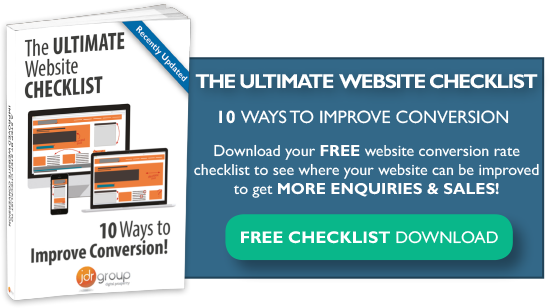Basic Principles Of Web Design For Marketers

Even for businesses that understand the need for a good website, it isn’t always clear how marketing principles can be built into the design itself to encourage more leads and higher conversions. Getting agreement to commit money to a new or redesigned website can be an uphill struggle, even when other marketing spend has been agreed. Even if you are lucky enough to have an in-house marketing team, they may not possess web design skills.
However, this doesn’t mean you can’t create a website that’s impressive and performs well as a lead gen tool. In this article, we will examine a few of the basic principles of web design that need to be followed in order to have a website that meets your marketing needs and impresses your visitors. Our goal is to build a case that web design should be seen as an integral part of marketing, rather than something that sits within the IT budget.
It’s All About Your Customers
A website needs to be designed for the audience your business is targeting. In order to do this, you need to define what it is you want your visitors to do when they get there. Perhaps you have a great product you want them to buy, or a B2B service to promote. Whatever the goal, the clearer it can be, the better. A clear goal will allow you to focus on what will be included in the content of the top pages of your website; especially your home and about pages. The content should take your visitors on a journey and lead them to where you want to go. In most cases this will be to submit an enquiry through one of your contact forms, and join your lead nurturing programme.
A Simple Map
There are many impressive navigation and website designs out there that you can take as inspiration. But when it comes to navigation, you should keep customer experience at the top of your mind. If the navigation design doesn’t follow the basic left-to-right direction that people read in and cannot be positioned in a logical location on the page, it can cause confusion and impatience, leading to the abandonment of your site. Keep your navigation simple and accessible to keep your bounce rate low. This means arranging the page hierarchy in a logical way and keeping your most important pages to the left of your top page navigation.
Mobile Matters
Higher numbers of visitors than ever are now using their mobile devices to access websites. If you’ve designed your website according to the way only a portion of customers are viewing it – e.g. optimised only for laptops – then you are missing out on a large number of potential leads. However, when your site can adapt to the screen size of virtually any device, you remain accessible to all your target market, at whatever time they choose to browse your site. For instance, a decision maker can browse your website on their iPhone while on the train home, rather than having to squeeze time in while at their office desktop.
However, simply having a responsive website is not enough. It needs to work effectively as a marketing tool at all sizes. Some mobile responsive sites are truly dreadful, as on the smallest screens they are text heavy and clearly not designed with marketing in mind. Content-driven mobile responsive design is one of the main reasons to consider working with an agency such as JDR when reviewing your website. Not only are our designers familiar with the coding requirements of responsive sites, but our marketing specialists can ensure that the most pertinent content is always clearly displayed to visitors in every site variant and screen resolution.
Short And To The Point
Every company wants to shout the benefits of their business from the rooftops. But in doing so it is easy to forget that your visitors are less concerned with who you are, than in what you can do for them. So concentrate all your images, videos and written content on your value proposition, and keep it as concise as you can. Excessive wordiness, lengthy company profiles and technical language will only ensure lower visitor numbers. Wherever possible, try to avoid unnecessary jargon or acronyms and use consumer language to get the message across. This is another argument in favour of having marketing specialists involved at every design stage from concept upwards.
The appearance of certain words is also important. For example, instead of using all capital letters to make a point, opt for italics or bold text on those words you feel are most important. Long text can also cause page abandonment, which is why you should break content up with shorter paragraphs and/or bulleted lists.
Business Objectives And Customer Needs
Any website content needs to be relevant to what customers are looking for. For example, if your content doesn’t answer your customer’s most urgent questions, you can’t expect them to get in touch to find out more. The relevance of any content is directly related to how well you know your visitors. Where are they coming from, and who are they? Writing content that’s in line with the answers to those questions will build your reputation as an industry expert. It will also help you to build a relationship with your visitors. You can help keep your website relevant by building your category and subcategory pages around keywords linked to your buyer personas. This ensures that marketing is always at the forefront of your website design and not an afterthought after the site is built.
Sharable Content
Another important web design element is to ensure there are as many ways as possible for visitors to share your content. Giving visitors the opportunity to share content on LinkedIn, Facebook, Twitter and other sites through share buttons means that content can be passively promoted as you work on other aspects of site marketing or design.
A Website Built For Lead Generation
The bottom line when designing a website is to remember that, while you are a marketer, you are also a consumer. What do you like most about the design of the websites you use? What part of a website you visited made it easy to do what you needed to do? These are the questions you can ask yourself when you’re designing your site for maximum impact on your visitors. A professional web design and marketing agency can help your website become a lead generation engine far faster than doing it on your own. When you work with JDR, we can get all these requirements factored in at the design stage to ensure the most user-friendly website for your target market.


